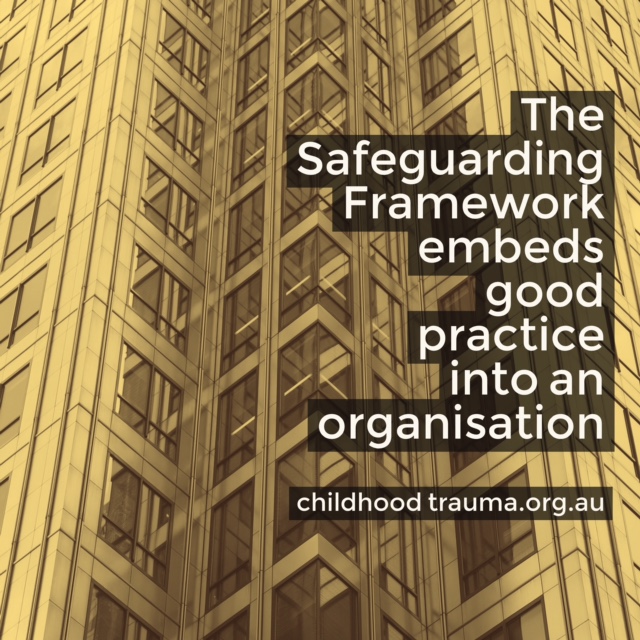
Maintaining a Safeguarding Culture
Consultant with the Safeguarding Children Program
at the Australian Childhood Foundation.
The Safeguarding Children Program is fundamentally about implementing and sustaining processes that create a safeguarding culture and ensure the on-going safety of children and young people within organisations. This usually involves significant changes in the way that organisations operate.
Implementing any change in an organisation can be challenging and often sustaining the changes that support a safeguarding culture can be even more challenging. It is not simply a matter of saying ‘we have implemented safeguarding so now we are there!’ It is an on-going journey. Here are several issues that can lead to the failure to implement a safeguarding culture successfully, these include that:
- the Safeguarding practice that has been adopted is not being used as it was designed; or
- the practice is put in place with fidelity, but does not last long enough to see any meaningful change; or
- the practice is put in place with fidelity, but on such a small scale that the true impact cannot be seen.
 These issues could arise because of significant changes in the organisation including changes in the key personnel with responsibility for the organisation’s safeguarding program or the addition of new programs that have not been inducted into safeguarding practices.
These issues could arise because of significant changes in the organisation including changes in the key personnel with responsibility for the organisation’s safeguarding program or the addition of new programs that have not been inducted into safeguarding practices.
The Safeguarding Framework outlines how specific elements of good practice are embedded into an organisation across a number of its management and practice systems in order to address known risk factors for organisational abuse. The Safeguarding Framework outlines how safeguarding practices are to be introduced into the organisation across several phases. The Safeguarding Framework recognises the Implementation and Maintenance of a Safeguarding culture as separate phases. Implementation Phase is where the adopted practice is initially implemented. The Maintenance Phase is where the intervention is embedded in the organisation as part of its culture including that there is:
- stable funding and support including for ongoing training needs
- ongoing fidelity monitoring i.e. building safeguarding into standard quality improvement and training practices and Policy and Procedure manuals; and
- regular examination and review of outcomes leading to refinements and additions as required.
In the Safeguarding Framework, implementation fidelity is initially tested through an initial external policy Compliance Review and Audit of the implementation of the safeguarding program including reviewing communication, training & administrative systems. Successful implementation of the safeguarding program in an organisation qualifies that organisation for accreditation through the Safeguarding Program for a period of three years. To maintain accredited status an organisation is required to continue to meet the requirements of each of the Safeguarding Children Program standards throughout the term its accreditation. The Australian Childhood Foundation reserves the right to suspend or rescind accreditation if an organisation fails to maintain the requirements of each of the standards. At the end of the first and second years of accreditation an organisation required to complete self-assessment reports to its ongoing compliance with the standards of the Safeguarding Children Program. The self-assessment reports form the basis of the annual self-review the organisation is required to complete to retain accreditation. The on-line Safeguarding Manager makes this a very clear and simple to use process. System-generated emails advise organisations when each annual review is due and provide the annual self-assessment review documentation required to complete the Annual Review.
Safeguarding Children Program standards throughout the term its accreditation. The Australian Childhood Foundation reserves the right to suspend or rescind accreditation if an organisation fails to maintain the requirements of each of the standards. At the end of the first and second years of accreditation an organisation required to complete self-assessment reports to its ongoing compliance with the standards of the Safeguarding Children Program. The self-assessment reports form the basis of the annual self-review the organisation is required to complete to retain accreditation. The on-line Safeguarding Manager makes this a very clear and simple to use process. System-generated emails advise organisations when each annual review is due and provide the annual self-assessment review documentation required to complete the Annual Review.
At the end of three-year accreditation period, the Safeguarding Manager will send an email to advise the organisation that it is due to undertake re-accreditation. This is sent 6 months prior to the date on which the initial accreditation expires to enable the organisation to submit documentation for re-accreditation and undergo a re-accreditation audit. Extension of accreditation can be granted by the Australian Childhood Foundation if the re-accreditation process is sufficiently advanced.
Through these simple processes the successful implementation and maintenance of Safeguarding practices is unsupported and monitored to ensure that fidelity to program goals is achieved.
